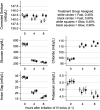Effects of Fluid Rehydration Strategy on Correction of Acidosis and Electrolyte Abnormalities in Children With Diabetic Ketoacidosis
- PMID: 34187840
- PMCID: PMC8740930
- DOI: 10.2337/dc20-3113
Effects of Fluid Rehydration Strategy on Correction of Acidosis and Electrolyte Abnormalities in Children With Diabetic Ketoacidosis
Abstract
Objective: Fluid replacement to correct dehydration, acidosis, and electrolyte abnormalities is the cornerstone of treatment for diabetic ketoacidosis (DKA), but little is known about optimal fluid infusion rates and electrolyte content. The objective of this study was to evaluate whether different fluid protocols affect the rate of normalization of biochemical derangements during DKA treatment.
Research design and methods: The current analysis involved moderate or severe DKA episodes (n = 714) in children age <18 years enrolled in the Fluid Therapies Under Investigation in DKA (FLUID) Trial. Children were assigned to one of four treatment groups using a 2 × 2 factorial design (0.90% or 0.45% saline and fast or slow rate of administration).
Results: The rate of change of pH did not differ by treatment arm, but Pco2 increased more rapidly in the fast versus slow fluid infusion arms during the initial 4 h of treatment. The anion gap also decreased more rapidly in the fast versus slow infusion arms during the initial 4 and 8 h. Glucose-corrected sodium levels remained stable in patients assigned to 0.90% saline but decreased in those assigned to 0.45% saline at 4 and 8 h. Potassium levels decreased, while chloride levels increased more rapidly with 0.90% versus 0.45% saline. Hyperchloremic acidosis occurred more frequently in patients in the fast arms (46.1%) versus the slow arms (35.2%).
Conclusions: In children treated for DKA, faster fluid administration rates led to a more rapid normalization of anion gap and Pco2 than slower fluid infusion rates but were associated with an increased frequency of hyperchloremic acidosis.
Trial registration: ClinicalTrials.gov NCT00629707.
© 2021 by the American Diabetes Association.
Figures
References
-
- Rewers A, Dong F, Slover RH, Klingensmith GJ, Rewers M. Incidence of diabetic ketoacidosis at diagnosis of type 1 diabetes in Colorado youth, 1998-2012. JAMA 2015;313:1570–1572 - PubMed
-
- Jensen ET, Stafford JM, D’Agostino RB Jr., et al. . Rapid increase in prevalence of DKA at diagnosis among youth with type 1 diabetes: the SEARCH for Diabetes in Youth study. Oral presentation at the 55th European Association for the Study of Diabetes Annual Meeting, 16–20 September 2019, Barcelona, Spain
-
- Rewers A, Chase HP, Mackenzie T, et al. . Predictors of acute complications in children with type 1 diabetes. JAMA 2002;287:2511–2518 - PubMed



